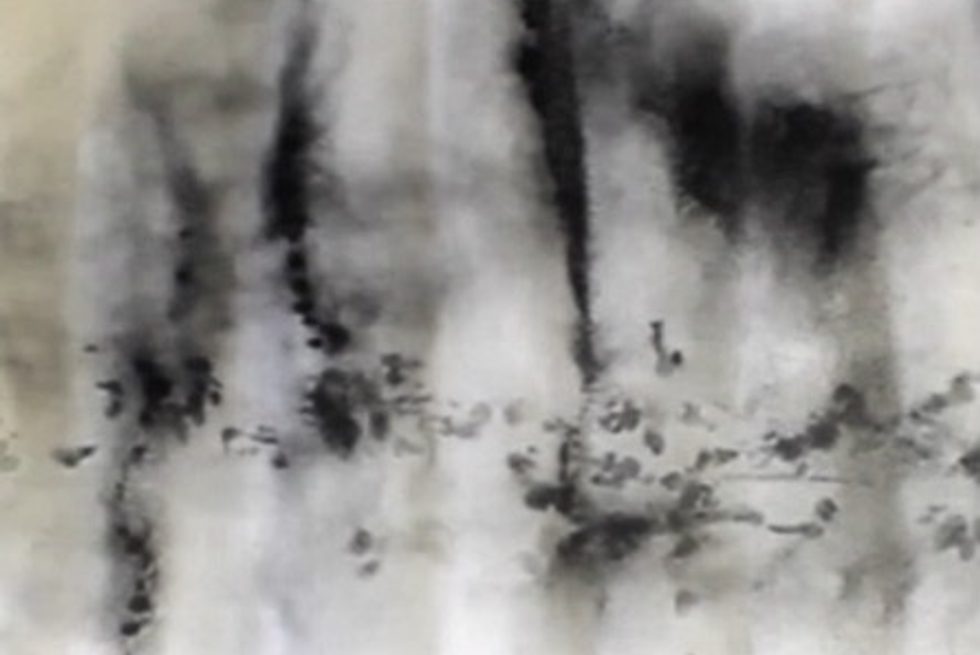
In the event of Re-sounding Movements, drawing resonates across the vital spaces of the in-between, attempting to capture the felt vitality of passages forming relationally within and across bodies. The in-between, to be differentiated from the between that divides and separates, is "a movement of generation and dissolution in a world of becoming where things are not yet given . . . an interstitial differentiation, a fission/fusion reaction, a winding and unwinding, inhalation and exhalation" (Ingold 2015, 147). Not mediation joining distinct entities from the outside, but rather immediation: a coming-together into relation for the sake of collective change and becoming; an event of co-composition (Massumi 2018). The interval probed here is a line of flight that emerges as atmospheric where "atmosphere is about the sensory experience . . . a space of affect": an "indeterminate spatially extended quality of feeling" (Ingold 2015, 73).
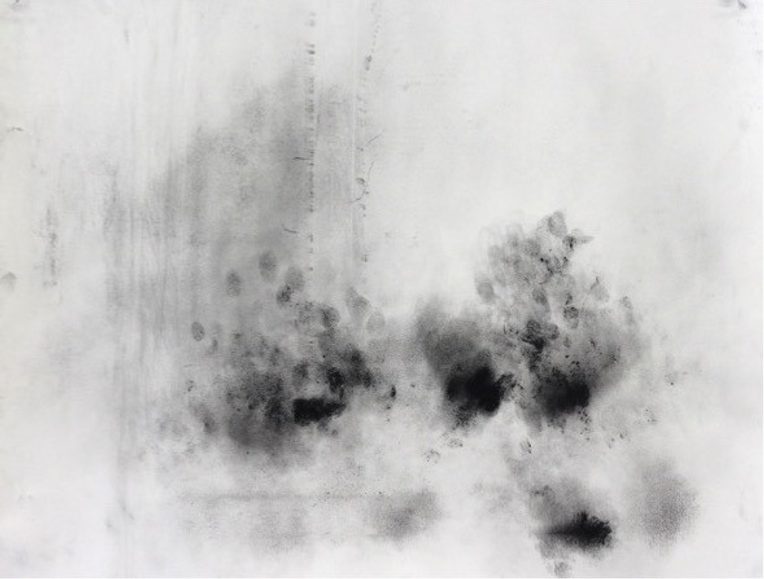
re-sounding 2_frame drum from Renée Charron on Vimeo.
The series of collaborative drawings and videos (involving the percussionist Michel Bonneau and me) attempts to seize the flow and resonance of sound, tracing the ephemerality of the musician’s gestures as he improvises in the interval of rhythms and their corporeal-material manifestation. Charcoal (and pigment) powder was sprinkled onto resilient surfaces of paper that were loosely stretched over various percussion instruments. (Different colored natural pigments were explored for their distinctive qualities of weight and volatility.) The musician then improvised with these instruments, leaving traces of rhythmic forces as they responded to the thin resounding membranes and coalesced in the space in-between volatile charcoal powder and sonorous reverberation (images 1–2, video 1). The fingers, as Tim Ingold (2015, 109) points out about the cello player, "show up simultaneously in two quite different ways, at once corporeal, in the haptic space of performance, and as phantom, in the atmospheric space of explosion." Here, "sound wraps around [fingers, palms or mallets] forming eddies in the process. Every eddy is a center of auditory awareness" (Ingold 2015, 108). Re-sounding Movements exposes the haptic in the optical and auditory as corporeal forces carry the charcoal in the air, flowing, fluctuating, and fusing over the interacting membranes of paper and goat’s hide. A smooth space emerges, "occupied by intensities, wind and noise, forces, and sonorous and tactile qualities" (Deleuze and Guattari 1989, 479). It is a "nomadic absolute that is one with becoming itself, with process. It is the absolute passage, which in nomad art merges with its manifestation" (Deleuze and Guattari 1989, 494). Smooth space is continually being traversed and transformed by the striated space of markings (or fingerprints) on the paper that punctuate and fix the charcoal to the surface while simultaneously propelling it above. Striated space is at once immobilized and dissolved, enabling smooth space to develop in the process; nomad space and sedentary space coexist in their formation. The process of coordinated forming that is played out between vital body, sound, matter, and air embody a temporal experience that is amorphous, heterogeneous in its continuum, and haptic; it is an atmospheric time, perceived in the attunement of attention and response to rhythmic relations.
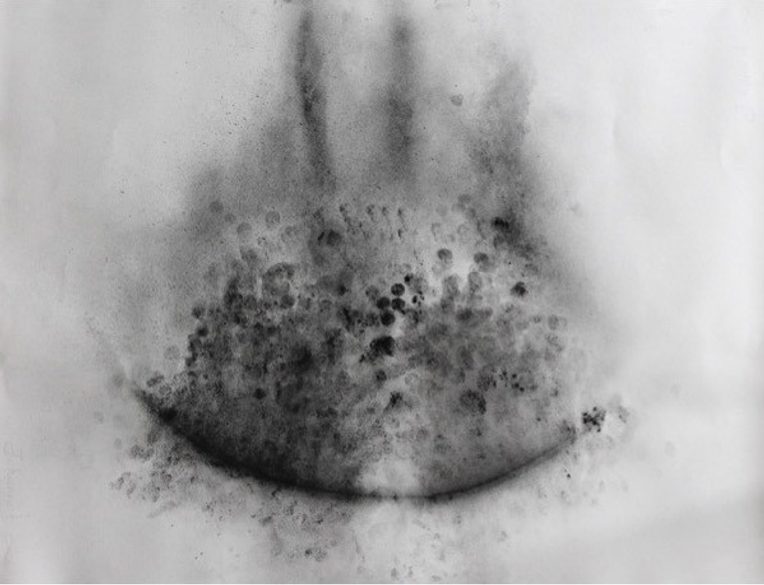

In Japanese culture the notion of the in-between or interval (ma) is implicit in all facets of life: spiritual, social, and practical, and subsumes poetic and artistic philosophies and practices. The intervallic space presupposes an inherent temporal dimension and a mode of experience, of awareness and of knowing. Christine Buci-Glucksmann (2001, 36, my translation) gives us a glimpse into its essence:
Ma is at once interval, void and spacing, “between” in its fullest sense. It separates, links, and sets a breathing, a fluctuation and an incompleteness which engenders a relation of time to infinity specific to Japan. For the interval establishes at once a distance and a dynamics, a void and a plurality of senses.
In drawing, ma is the temporal space that is activated by the artist’s strokes. It is tightly imbricated with the concept of Void as Nothingness and Plenitude.
The Void, argues Henri Maldiney (2003), is a space of passage in which vital breath circulates and communicates its rhythmic variations. The mutation of the Void incarnated in the interpenetration of Plenitude and Nothingness, or of ink and the white of the paper, characterizes the correlation of time and space. It implies a co-composition of relations and exchanges, a system of potentiality of mutual inclusions and exclusions in the event of its opening-up. It impels a reciprocal transformation freed of preconditioned possibilities and intentions. In opposition to traditional western practices, which conceive of drawing as the image (representation) of reality, Eastern practices present reality as image: the former consists of the illusion of its appearance, the latter, the event of its actual appearing (Maldiney 2003, 194). The very "idea of mutation" Maldiney (2003, 199, my translation) claims, "implies a spatio-temporal dynamic that establishes in appearance, the moment of appearing." And "the appearing of an event is the event of its opening" (Maldiney 2003, 210, my translation).
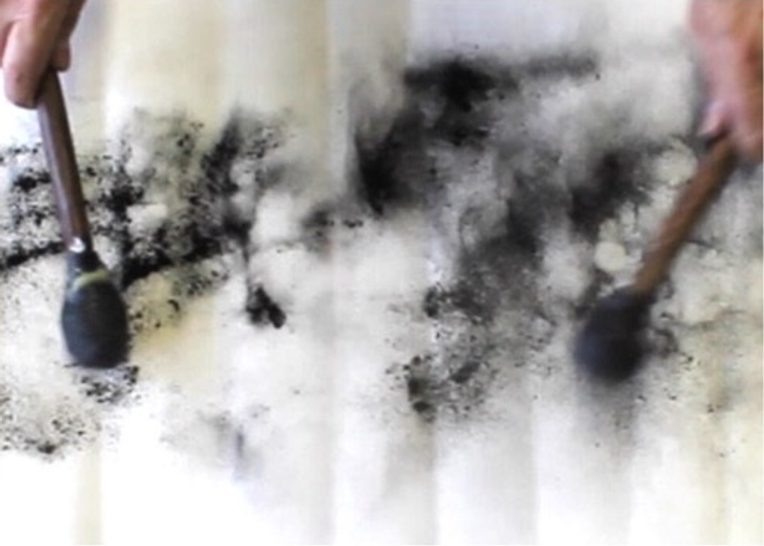

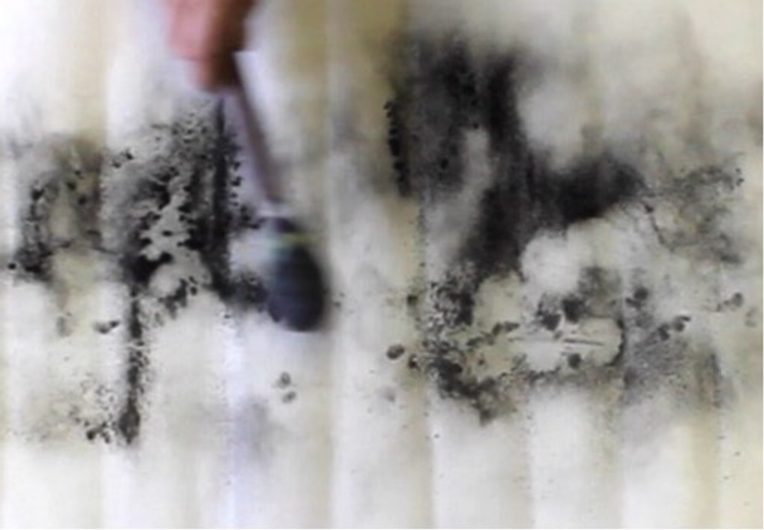

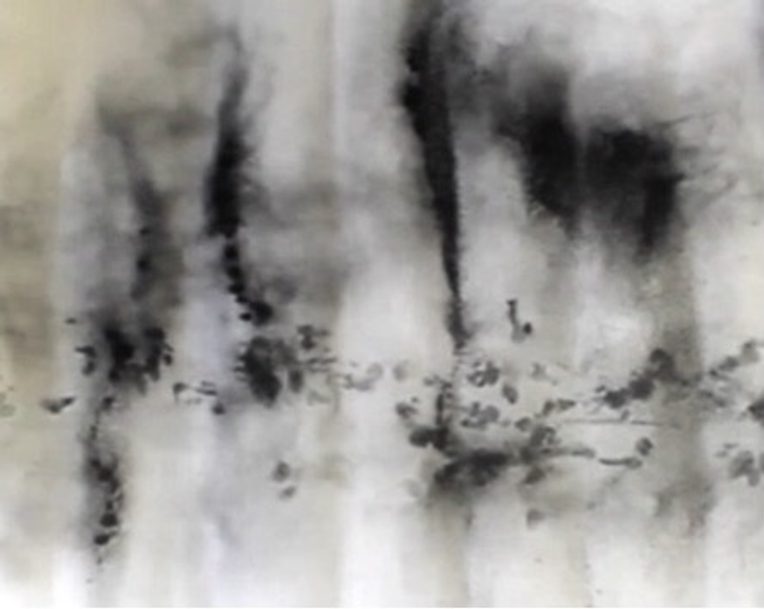
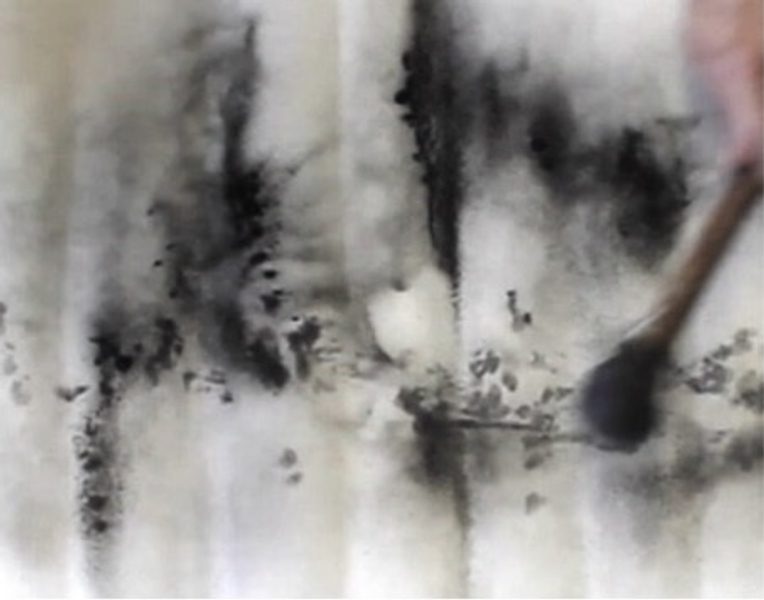
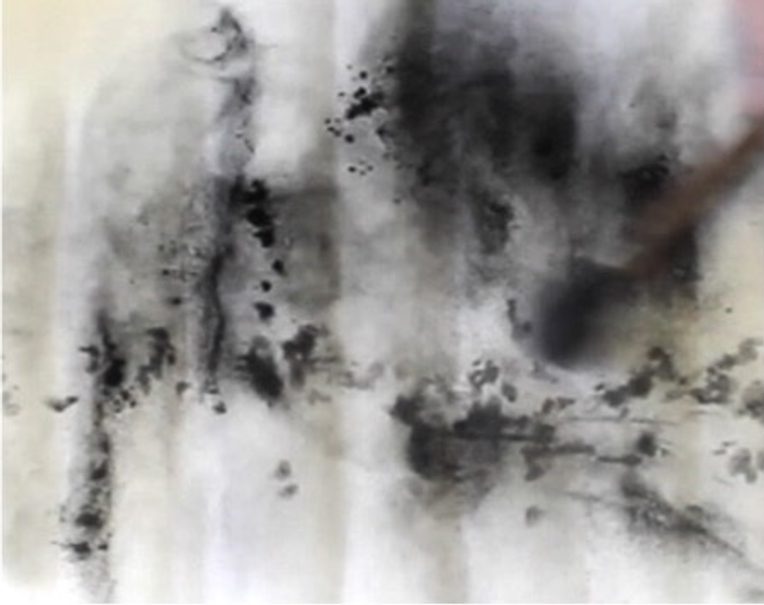

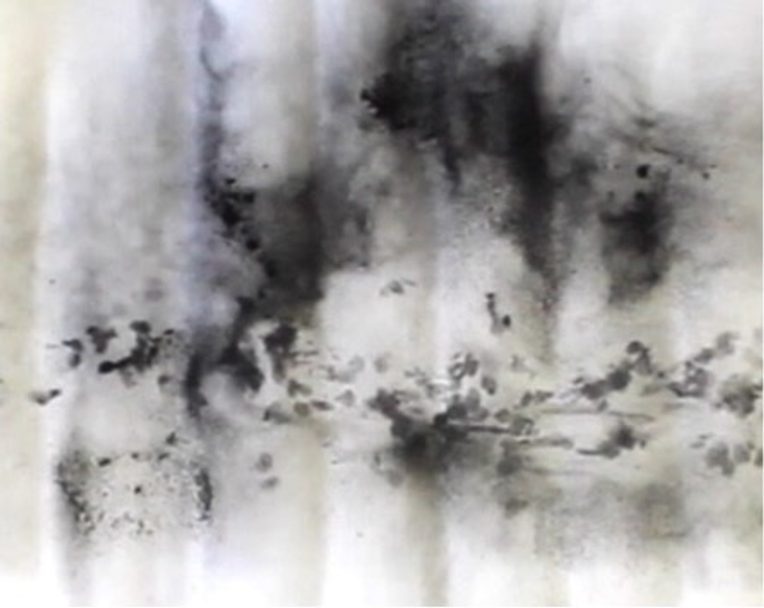
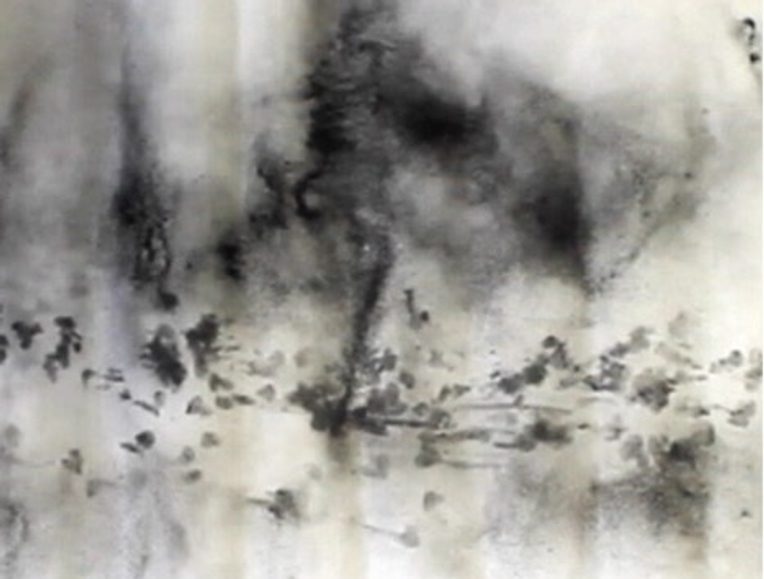
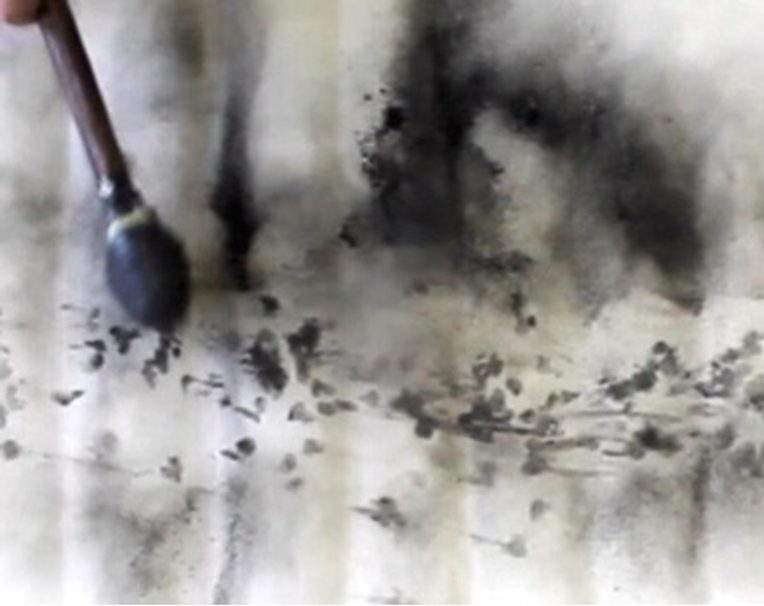
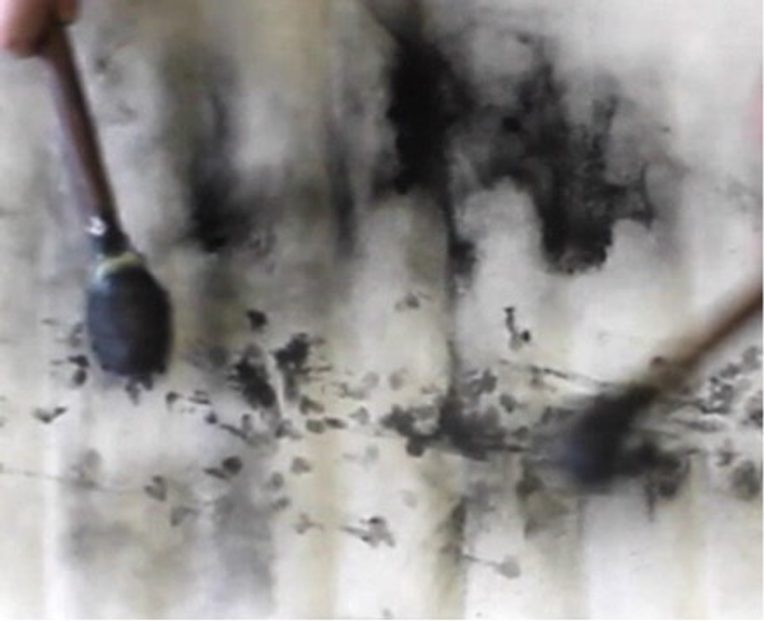
I look to this Asian perspective in order to broach the essence of a piece that was co-composed with a Balafon. The piece was created in the same manner as the various drum pieces except that, given the density of the paper, folds had to be lightly pressed into the surface between the keys for the musician to orient himself. The linear folds became an important structural element in the composing of the piece as they both attracted and repulsed the charcoal powder in their own rhythmic manner, directly affecting the nature of the pigment’s trajectories across the space. As I began to study a sequence of stills from the performance video, I detected formations in the charcoal that were reminiscent of Chinese and Japanese calligraphy. As I proceeded along the sequence the calligraphic characters gave way to morphing landscapes in which clouds seemed to emerge and metamorphose with the circulating air propelled by the forces of resounding sounds and corporeal gestures. The vertical fold structure correlated with the dynamics of gravity both materially (as it pulled the charcoal down into its grounded crevices) and pictorially (as it evoked the vertical tendency of nature’s unfolding). The undulating relief inscribed in the fabric of the paper re-acted as a generative force and as a trace of the rippling turbulence that intervened in the flow of particles and its nebular formations. The very nature of the event of formation seemed to embody the essence of Japanese drawing, both calligraphic and figurative, which to me is a primary source of drawing as corporeal process. And so it is through this lens that I write about this piece, only to intertwine it with western views.
Calligraphic characters are highly structured relative to an imaginary gridded square. Knowing how to maintain an awareness of the center of gravity within this frame in order to play with asymmetries, disarticulations and disjunctions that activate and harmonize as well as heightening the tensions and energy of not only the elements of a character but also of the various characters within a textual ensemble, is essential to any good calligraphy. In Jean-François Billeter’s (1989, 32, my translation) words, it is a question of
conjugating the largest possible number of these dispositions so as to create a complex network of tensions and exchanges, between the parts of a character, a play of energies that act powerfully one on the other while reciprocally self-containing each other. By doing this each character becomes the equivalent of a center of energy or a living organism. Inhabited by a life more intense than its ambient environment, it removes itself so as to take on a life of its own.
Hence, calligraphy (and Japanese painting) is highly immersed in a sense of corporeality: it aspires to create an organism both modeled on, and in attunement with the living, breathing body. The artist’s emergent impulses of in-corporeal energy are embodied and liberated into the flow of ink as it fuses with the substance of the paper. Re-sounding Movements is, likewise, the in-corporeal manifestation of the forces and energies that engender the event of appearing-disappearing, metamorphosing inner movements, but its medium is aerial rather than aqueous.
Billeter, furthermore, establishes a strong correlation between the essence of calligraphy and that of music. Both, he argues, emerge as a metamorphosis of gesture borne of duration, the experience of time and space in the execution of calligraphy is, in essence, the same as that of playing an instrument. Yet, we might speak of two intertwined spatio-temporalities: one is borne of the duration of the performance, the other of the time of the trace that sets in motion a referral of signs to others. Although these signs in calligraphy point in part to the signified, they share with Re-sounding Movements the immanent significance of a sensing that is "offered right at the body," a sensing or a trait of sensation that "thrusts open that through which all relations and distinctions are opened" (Nancy 2013, 41). Like the calligrapher, when the musician improvises he projects his inner space, invested with affects and forces onto the surface of paper, imbuing it with a diversity of textures and emotions. Internal and external space become one coextensive whole, as external space turns back onto internal space sustaining it in return. Whether through ink or charcoal, interior and exterior forces come together to mobilize transforming energies and these energies once liberated are diffused throughout the space of the body to augment and heighten the kinaesthetic activity, and vitalize motor imagination. In the case of the latter, the forces of volition of the charcoal, generated by sounding resonances magnetize, orient and drive the gestures of the musician; virtual powers are actualized and potentiated simultaneously within the space of performance. As Jean-Luc Nancy (2015, 19) so eloquently words it,
[sound] is made of referrals: it spreads in space, where it resounds while still resounding “in me” . . . In the external or internal space, it resounds, that is, it re-emits itself while still actually “sounding,” which is already “re-sounding” since that’s nothing else but referring back to itself. To sound is to vibrate in itself or by itself: it is not only, for the sonorous body, to emit a sound, but it is also to stretch out, to carry itself and be resolved into vibrations that both return to itself and place it outside itself.
The Japanese perception of the body is not fixed, reality is apprehended as changing and is recognized in the spectacle of clouds (Billeter 1989, 183). There is also a very strong correspondence between "man" and "nature" in Asian culture, most evident in its painting practices in which the clouds hold a special place. Between the two poles of mountain and water, earth and sky, that constitute reality, the Void circulates and is represented by the cloud. This Void is not an inert presence but is traveled by wind, the vital breath that links the visible to the invisible and fuses mountain with water. It at once condenses water into a cloud and embraces the mountain with it (Cheng 1979, 22). The cloud is a world of mutation, a model of metamorphosis, anamorphous deformation, the dissolution of delimiting contours, and the essence of the atmosphere. The mutating cloud of charcoal in Re-sounding Movements becomes significant as the incarnation of process in drawing. If the cloud is a privileged conductor of reverie and imagination, according to Hubert Damisch, "it is because it contradicts the order of delimitation and contour and rather appertains to matter in that it aspires to form" (1972, 55, emphasis added). It is the thickening of atmosphere as much as it is corporeal, “obeying, like any other body, the laws of movement and weight” (Damisch 1972, 217, my translation).
Re-sounding Movements sounds the body’s ability to feel the space of the in-between, to interact with, and to be reassembled in other bodies. Perhaps I could borrow Madeline Gins and Shusaku Arakawa’s (2002, 2) expression: “‘organism that persons’ because it portrays persons as being intermittent and transitory outcomes of coordinated forming rather than honest-to-goodness entities.” In this co-forming, new relations emerge that extend the spectrum of potentiality and mobilize intensities and vitality affects. The co-adventure of Re-sounding Movements has in us, Michel and me, reinforced at a micro level our sense of time and space and what it is to ride the plane of immanence: the binding force that enables thought and body to connect, relate, converge and diverge, and create alliances and tensions whose intensities are ever-changing. What is left, on our walls, of the in-between is the trace of ephemerality that can only resound in the body as sensation, recomposing the sensuous intensities that inhabit the paper. It is of a duration that is bound with the past and emergent virtualities of potential future encounters. But for now:
like a wave that is born of another wave, only the body can decrypt the echoes of a resonance that returns, in the matter of paper as a silenced percussion, of which we only need to awaken the blows. (Louppe 1991, 24, my translation)

References
Billeter, Jean-François. 1989. L’art chinois de l’écriture. Geneva: Editions d’Art Albert Skira S.A.
Buci-Glucksmann, Christine. 2001. L’esthétique du temps au Japon: Du zen au virtuel. Paris: Éditions Galilée.
Cheng, François. 1979. Vide et plein: Le langage pictural chinois. Paris: Éditions du Seuil.
Damisch, Hubert. 1972. Théorie du nuage: Pour une histoire de la peinture. Paris: Éditions du Seuil.
Deleuze, Gilles, and Félix Guattari. 1989. A Thousand Plateaus: Capitalism and Schizophrenia. Translated by Brian Massumi. Minneapolis: University of Minnesota Press.
Gins, Madeline, and Shusaku Arakawa. 2002. Architectural Body. Tuscaloosa: University of Alabama Press.
Ingold, Tim. 2015. The Life of Lines. New York: Routledge.
Louppe, Lauence. 1991. Danses tracées: Dessins et notation des chorégraphes. Paris: Éditions Dis Voir.
Maldiney, Henri. 2003. "L’art et le rie." In Art et existence, 171–213. Paris: Klincksieck et Cie.
Massumi, Brian. 2018. “Immediation Unlimited.” In Immediations, edited by Erin Manning, Anna Munster, and Bodil Marie Stavning Thomsen. London: Open Humanities Press.
Nancy, Jean-Luc. 2013. The Pleasure in Drawing. Translated by Philip Armstrong. New York: Fordham University Press.
———. 2015. “On Listening.” In The improvisation Studies Reader: Spontaneous Acts, edited by Rebecca Caines and Ajay Heble, 17–27. New York: Routledge.